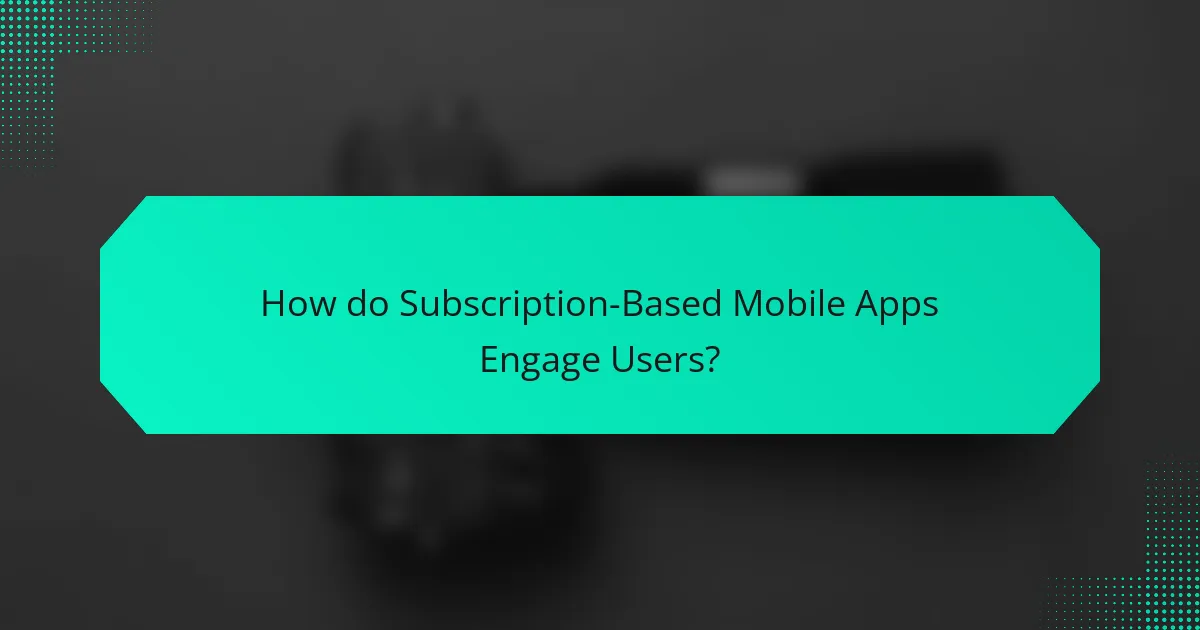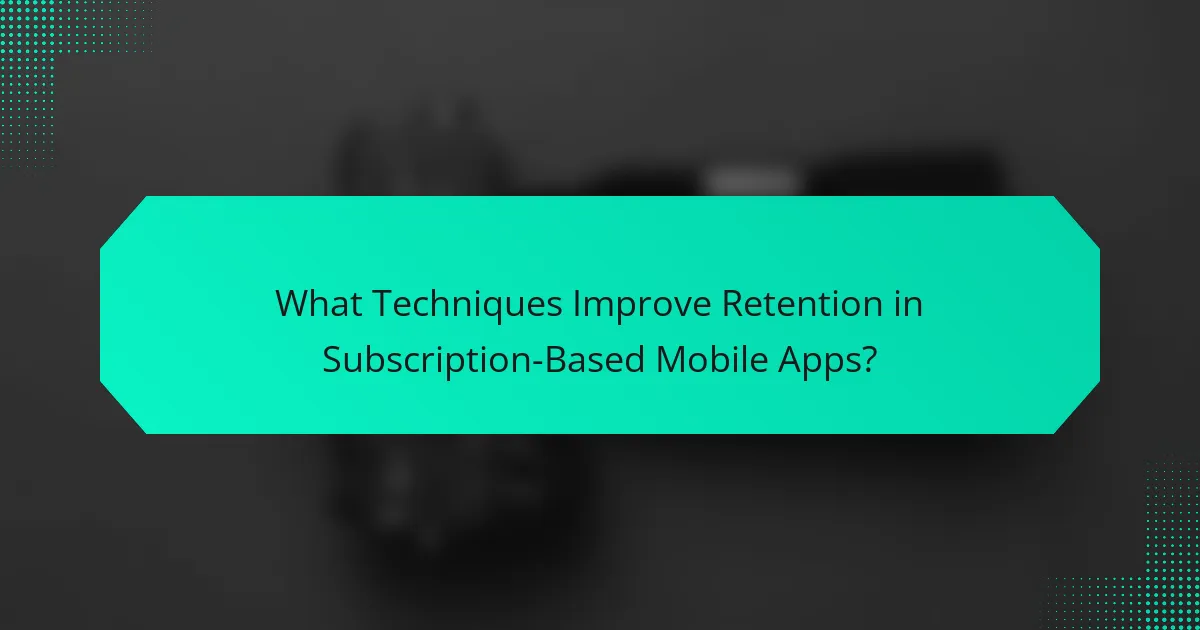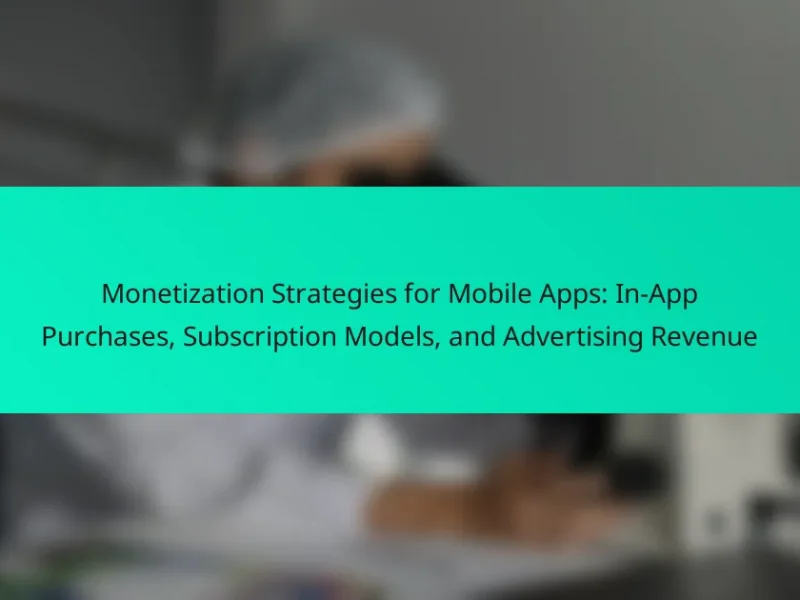Subscription-based mobile apps are applications that require users to pay a recurring fee for access to features and content, typically structured in various tiers such as monthly, quarterly, or annual payments. This revenue model is increasingly popular, with the subscription app market projected to reach $1 trillion by 2025, reflecting a consumer shift toward these services. The article explores key aspects of subscription-based mobile apps, including pricing models, user engagement strategies such as personalized content and community features, and retention techniques like personalized onboarding and push notifications. It highlights the importance of these elements in fostering user loyalty and reducing churn rates, supported by relevant statistics and studies.

What are Subscription-Based Mobile Apps?
Subscription-based mobile apps are applications that require users to pay a recurring fee to access their features and content. These apps typically offer various subscription tiers, providing users with different levels of service. Commonly, subscription models include monthly, quarterly, or annual payments. This approach allows developers to generate consistent revenue over time. Popular examples include streaming services and productivity tools. According to a report by Statista, the subscription app market is projected to reach $1 trillion by 2025. This growth highlights the increasing consumer preference for subscription-based services.
How do subscription-based mobile apps differ from other app models?
Subscription-based mobile apps differ from other app models primarily in their payment structure. Users pay a recurring fee for access to the app’s features and content. This model contrasts with one-time purchase apps, where users pay a single fee upfront. Subscription apps often provide continuous updates and new content, enhancing user engagement. In 2021, subscription apps generated over $13 billion in revenue, highlighting their popularity. Additionally, subscription models can lead to higher customer lifetime value compared to traditional models. This is due to the ongoing revenue stream and the potential for long-term user retention.
What are the primary features of subscription-based mobile apps?
Subscription-based mobile apps typically offer features like recurring billing, user account management, and tiered subscription plans. Recurring billing allows users to make regular payments for continued access to app content. User account management enables personalization and tracking of subscription status. Tiered subscription plans provide varying levels of access or features based on payment levels. Additionally, many apps include free trials to attract new users. Push notifications are often used to engage users and remind them of subscription benefits. Analytics are employed to track user behavior and optimize retention strategies. These features collectively enhance user experience and drive revenue for app developers.
Why are subscription-based models gaining popularity among developers?
Subscription-based models are gaining popularity among developers due to their ability to generate consistent revenue. This model allows developers to establish a predictable income stream over time. According to a report by Statista, subscription revenue in the app industry is expected to reach $157 billion by 2024. This growth is driven by user preference for ongoing access to services rather than one-time purchases. Additionally, subscription models encourage user engagement and retention, as users are more likely to continuously use the app to justify their investment. The recurring nature of subscriptions also enables developers to invest in ongoing updates and improvements, enhancing user satisfaction.
What are the common pricing models for subscription-based mobile apps?
Common pricing models for subscription-based mobile apps include monthly subscriptions, annual subscriptions, freemium models, and tiered pricing. Monthly subscriptions require users to pay a set fee each month. Annual subscriptions offer a discounted rate for a full year of access. Freemium models provide basic features for free while charging for premium features. Tiered pricing allows users to choose from different levels of service at varying price points. These models cater to diverse user preferences and maximize revenue potential. According to a study by Statista, subscription-based apps have seen a significant increase in revenue, indicating the effectiveness of these pricing strategies.
How do tiered pricing models work in subscription apps?
Tiered pricing models in subscription apps offer multiple pricing levels based on features or usage. Each tier typically provides different benefits, appealing to various user needs. For instance, a basic tier may include essential features, while higher tiers offer advanced functionalities. This structure allows users to choose a plan that fits their budget and requirements.
Research indicates that tiered pricing can increase revenue by catering to diverse customer segments. According to a study by McKinsey & Company, businesses implementing tiered pricing saw a 20-30% increase in conversion rates. This model encourages users to upgrade as their needs grow, fostering long-term engagement.
What is the significance of freemium pricing in subscription apps?
Freemium pricing is significant in subscription apps as it allows users to access basic features for free while offering premium features at a cost. This model attracts a larger user base since it lowers the barrier to entry. Users can experience the app’s value without an initial financial commitment. According to a report by App Annie, 75% of mobile apps use a freemium model, highlighting its popularity. This approach enhances user engagement by encouraging exploration and usage of the app. Ultimately, it can lead to higher conversion rates as satisfied users may opt for paid subscriptions.
What factors influence the pricing strategies of subscription-based mobile apps?
Pricing strategies of subscription-based mobile apps are influenced by several key factors. Market demand plays a critical role in determining pricing. Apps that meet high user needs can command higher prices. Competitor pricing also impacts strategy; developers often adjust prices based on similar apps in the market. User demographics, including age and income, affect willingness to pay. The perceived value of the app, based on features and benefits, influences pricing decisions. Additionally, marketing strategies and promotional offers can shape pricing models. User feedback and engagement metrics provide insights for ongoing pricing adjustments. According to a study by App Annie, 90% of top apps use subscription models, highlighting the importance of strategic pricing.
How does market demand affect pricing models?
Market demand significantly influences pricing models. When demand for a product or service increases, companies often raise prices to maximize revenue. Conversely, if demand decreases, firms may lower prices to attract more customers. For example, in the mobile app industry, a surge in user interest can lead to higher subscription fees. Research shows that apps with higher demand can command premium pricing due to perceived value. Additionally, competitive analysis reveals that pricing strategies adapt based on market demand fluctuations. Thus, understanding demand is crucial for effective pricing model development.
What role does competition play in determining app pricing?
Competition significantly influences app pricing. It creates a benchmark for developers to set their prices. If competing apps offer similar features at lower prices, developers may need to adjust their pricing strategies. This adjustment can involve lowering prices or enhancing features to justify higher costs. Market analysis shows that apps with competitive pricing often achieve better user acquisition rates. For instance, a study by Sensor Tower indicates that apps priced competitively can increase downloads by up to 30%. Therefore, understanding competitive pricing dynamics is essential for maximizing app profitability.

How do Subscription-Based Mobile Apps Engage Users?
Subscription-based mobile apps engage users through personalized content, regular updates, and community features. Personalized content is tailored to user preferences, enhancing relevance and satisfaction. Regular updates keep the app fresh, encouraging users to return frequently. Community features foster interaction among users, creating a sense of belonging. Gamification elements, such as rewards or challenges, motivate continued use. Push notifications remind users of new content or features, driving engagement. Offering free trials allows users to experience value before commitment. According to a study by Statista, 67% of users are more likely to engage with apps that offer personalized experiences.
What are effective user engagement strategies for subscription apps?
Effective user engagement strategies for subscription apps include personalized content, push notifications, and community building. Personalized content enhances user experience by tailoring offerings to individual preferences. Push notifications keep users informed about new features or content updates, increasing interaction. Community building fosters user loyalty through forums or social media groups, allowing users to connect. Offering incentives like discounts or exclusive content also boosts engagement. Regular feedback collection helps to adapt the app to user needs, enhancing satisfaction. According to a study by Localytics, apps that use personalized push notifications see a 4x increase in engagement.
How can personalized content enhance user engagement?
Personalized content enhances user engagement by tailoring experiences to individual preferences. This customization increases relevance, making users more likely to interact with the content. Studies show that 80% of consumers are more likely to make a purchase when offered personalized experiences. Furthermore, personalized recommendations can lead to a 300% increase in conversion rates. By addressing specific user needs, personalized content fosters a deeper emotional connection. This connection encourages users to spend more time on the app, thus improving retention rates. Overall, personalized content significantly boosts user satisfaction and loyalty.
What role does gamification play in user retention?
Gamification enhances user retention by increasing engagement and motivation. It incorporates game-like elements such as rewards, challenges, and leaderboards into non-game contexts. These features encourage users to interact more frequently with the app. For example, a study by Hamari et al. (2014) found that gamification positively affects user engagement, leading to higher retention rates. Users are more likely to return when they have goals to achieve and rewards to earn. Additionally, gamification fosters a sense of community through social interactions, which can further enhance loyalty to the app. Overall, gamification serves as a strategic tool to maintain user interest and commitment in subscription-based mobile apps.
Why is user feedback important for engagement in subscription apps?
User feedback is crucial for engagement in subscription apps because it directly informs app developers about user satisfaction and preferences. This feedback allows developers to identify areas for improvement. By addressing user concerns, apps can enhance their features and functionality. Improved features lead to higher user satisfaction. Satisfied users are more likely to continue their subscriptions. Research indicates that 70% of users are more engaged when their feedback is considered. Regularly incorporating feedback fosters a sense of community among users. This sense of community further encourages ongoing engagement and loyalty to the app.
How can app developers implement user feedback effectively?
App developers can implement user feedback effectively by systematically collecting, analyzing, and acting on it. First, developers should utilize in-app surveys to gather real-time feedback from users. This method allows for direct insights into user experiences and preferences. Additionally, monitoring app store reviews provides valuable feedback on user satisfaction and areas for improvement.
Developers should categorize feedback into themes to identify common issues or requests. This helps prioritize which features or fixes to address first. Implementing a feedback loop is crucial; developers should inform users about changes made based on their suggestions. This fosters a sense of community and encourages further feedback.
Regularly updating the app based on user feedback can enhance user engagement and retention. Studies show that apps that actively respond to user feedback see higher ratings and increased user loyalty. By adopting these strategies, app developers can create a more user-centered product that meets the needs and expectations of their audience.
What tools can be used to gather user feedback efficiently?
Surveys and feedback forms are effective tools for gathering user feedback efficiently. Platforms like SurveyMonkey and Google Forms allow for easy creation and distribution of surveys. These tools enable users to provide feedback on their experiences and preferences. Additionally, in-app feedback tools like Usabilla and Apptentive facilitate real-time user input. Social media platforms also serve as valuable channels for collecting feedback. They allow users to express their opinions and suggestions openly. Analytics tools, such as Mixpanel and Hotjar, can track user interactions and infer feedback indirectly. Each of these tools offers unique features that enhance the feedback collection process.
How can subscription-based mobile apps utilize data analytics for user engagement?
Subscription-based mobile apps can utilize data analytics to enhance user engagement by analyzing user behavior patterns. This analysis helps identify which features users interact with most frequently. It allows developers to tailor content and notifications to individual preferences. Data analytics can also segment users based on engagement levels, enabling targeted marketing strategies. Additionally, tracking churn rates through analytics helps in understanding why users unsubscribe. This information can inform improvements in app functionality and user experience. According to a study by McKinsey, companies leveraging data analytics can increase customer engagement by up to 20%. Thus, effective use of data analytics directly correlates with higher user engagement in subscription-based mobile apps.
What metrics should developers track to assess user engagement?
Developers should track metrics such as Daily Active Users (DAU) and Monthly Active Users (MAU) to assess user engagement. DAU indicates the number of unique users interacting with the app daily. MAU measures unique users over a month, providing insights into longer-term engagement trends.
Session length is another important metric. It shows how much time users spend in the app per visit. High session lengths often indicate strong user interest. Retention rate is crucial as well. It reflects the percentage of users who return to the app after their first visit.
Churn rate, the opposite of retention, indicates how many users stop using the app over time. A high churn rate may signal issues with user satisfaction. Additionally, engagement rate, which combines actions like clicks and shares relative to user counts, reveals how actively users participate with the app’s features.
Tracking these metrics helps developers identify patterns and areas for improvement. This data-driven approach enhances user experience and boosts overall engagement.
How can predictive analytics improve user retention rates?
Predictive analytics can improve user retention rates by identifying at-risk users and personalizing engagement strategies. By analyzing user behavior data, predictive models can forecast which users are likely to churn. This enables businesses to proactively target these users with tailored offers or content. For instance, a study by McKinsey found that companies using predictive analytics improved retention rates by 10-15%. Furthermore, predictive analytics allows for segmentation of users based on their preferences and usage patterns. This targeted approach increases the likelihood of users finding value in the app, thus enhancing retention.

What Techniques Improve Retention in Subscription-Based Mobile Apps?
Techniques that improve retention in subscription-based mobile apps include personalized onboarding, regular engagement through notifications, and offering value-added features. Personalized onboarding helps users understand the app’s benefits quickly. Regular notifications keep users informed and engaged with new content or features. Value-added features enhance the user experience and encourage continued use. According to a study by Localytics, apps with personalized onboarding see a 50% increase in retention rates. Furthermore, apps that utilize push notifications can achieve a 20% higher retention rate compared to those that do not. These strategies collectively foster user loyalty and reduce churn.
What are the best practices for increasing user retention?
To increase user retention, implement personalized experiences. Tailored content enhances user engagement and satisfaction. Regularly update your app with new features. This keeps users interested and encourages continued use. Utilize push notifications wisely. They can remind users of your app’s value without being intrusive. Offer incentives for continued use, such as rewards or discounts. This motivates users to stay engaged. Analyze user behavior to identify drop-off points. Understanding where users lose interest allows for targeted improvements. Lastly, foster a community around your app. Engaging users through forums or social media can strengthen loyalty.
How can onboarding processes influence long-term retention?
Onboarding processes significantly influence long-term retention by ensuring users understand the app’s value and features. Effective onboarding reduces user confusion and enhances satisfaction. A smooth onboarding experience can lead to a 50% increase in user retention over the first month. Additionally, clear guidance during onboarding fosters user engagement, encouraging users to explore more features. Research shows that 86% of users who undergo effective onboarding are more likely to continue using the app after the first week. This highlights the importance of a structured onboarding process in maintaining user interest and commitment over time.
What role does customer support play in retaining subscribers?
Customer support plays a crucial role in retaining subscribers. Effective customer support enhances user satisfaction and builds trust. Subscribers are more likely to stay when their issues are resolved promptly. According to a study by HubSpot, 93% of customers are likely to make repeat purchases with companies that offer excellent customer service. Additionally, responsive support can reduce churn rates significantly. Providing clear communication and assistance fosters a positive user experience. This positive experience encourages subscribers to recommend the service to others. Overall, strong customer support is essential for long-term subscriber retention.
How can subscription-based apps leverage loyalty programs for retention?
Subscription-based apps can leverage loyalty programs to enhance user retention by offering rewards for consistent usage. These programs can provide users with points, discounts, or exclusive content based on their subscription duration or activity level. For instance, a study by Loyalty360 found that 77% of consumers are more likely to stay loyal to brands that offer loyalty programs. Additionally, personalized rewards can increase engagement, as 54% of consumers prefer tailored offers. By integrating these loyalty features, apps create a sense of value and appreciation, encouraging users to maintain their subscriptions.
What types of loyalty rewards are most effective for users?
Effective loyalty rewards for users include discounts, cashback, and exclusive access. Discounts provide immediate financial benefits, encouraging repeat purchases. Cashback offers users a percentage back on their spending, enhancing satisfaction. Exclusive access to products or services fosters a sense of belonging and appreciation. According to a study by Bond Brand Loyalty, 79% of consumers say loyalty programs make them more likely to continue doing business with a brand. This indicates that well-structured loyalty rewards significantly impact user retention and engagement.
How can referral programs enhance user retention?
Referral programs enhance user retention by incentivizing existing users to bring in new users. This creates a community-driven approach where users feel valued. When users refer friends, they often receive rewards, such as discounts or exclusive content. These incentives encourage users to remain engaged with the app.
Research shows that referred users are more likely to stay longer. According to a study by the Wharton School, referred customers have a 16% higher lifetime value. This demonstrates that referral programs can significantly impact user loyalty. Overall, the social proof and rewards associated with referrals foster a stronger connection to the app.
What challenges do subscription-based mobile apps face in retaining users?
Subscription-based mobile apps face significant challenges in retaining users. High churn rates are a primary issue, with studies showing that 80% of users stop using apps within three months. Users often feel overwhelmed by subscription costs, leading to cancellations. Additionally, competition in the app market is fierce, making it easy for users to switch to alternatives. Poor user experience can also drive users away; 70% of users abandon apps due to usability issues. Lack of perceived value is another challenge; if users do not see ongoing benefits, they are likely to unsubscribe. Lastly, insufficient engagement strategies can result in users losing interest over time. These factors collectively hinder user retention for subscription-based mobile apps.
How can churn rates be effectively monitored and analyzed?
Churn rates can be effectively monitored and analyzed using various metrics and tools. First, businesses should calculate the churn rate by dividing the number of customers lost during a specific period by the total number of customers at the beginning of that period. This provides a clear percentage that indicates customer retention levels.
Next, cohort analysis can be employed to identify patterns among different customer segments. By tracking specific groups over time, businesses can gain insights into which segments are more likely to churn. Additionally, customer feedback and surveys can help identify reasons for churn, providing actionable data for improvement.
Using analytics tools like Google Analytics or specialized software can automate data collection and provide real-time insights. These tools can track user behavior, engagement levels, and subscription changes, making it easier to spot trends.
Regularly reviewing these metrics helps businesses adapt their strategies to reduce churn. For instance, targeted marketing campaigns can be developed to re-engage at-risk customers. Implementing retention strategies based on data analysis can lead to improved customer satisfaction and lower churn rates.
What strategies can be employed to reduce churn in subscription apps?
To reduce churn in subscription apps, implement personalized user experiences. Tailoring content and recommendations increases engagement. Regularly communicate with users through targeted notifications. This keeps subscribers informed and connected. Offer flexible subscription options to meet diverse user needs. Users appreciate choices that fit their lifestyle. Utilize data analytics to identify at-risk subscribers. This allows proactive outreach to address concerns. Provide incentives for long-term commitment, such as discounts for annual subscriptions. Research shows that personalized strategies can lower churn rates significantly. Companies that engage users effectively see up to a 25% reduction in churn.
What are practical tips for optimizing subscription-based mobile apps?
To optimize subscription-based mobile apps, focus on enhancing user experience and retention. Implement a user-friendly interface to simplify navigation. Regularly update content to keep users engaged. Use personalized recommendations based on user behavior. Offer free trials to attract new subscribers. Analyze user feedback to identify pain points. Optimize pricing models to align with user expectations. Monitor app performance metrics to identify areas for improvement. These strategies can lead to increased user satisfaction and retention rates.
The main entity of this article is subscription-based mobile apps, which require users to pay a recurring fee for access to features and content. The article provides a comprehensive analysis of various aspects of subscription-based mobile apps, including their pricing models, such as monthly and freemium options, and user engagement strategies like personalized content and gamification. It also addresses retention techniques, emphasizing the importance of user feedback, onboarding processes, and loyalty programs in maintaining subscriber interest. Additionally, the article highlights the challenges faced by these apps, such as high churn rates and competition, and offers practical tips for optimizing user experience and reducing churn.


